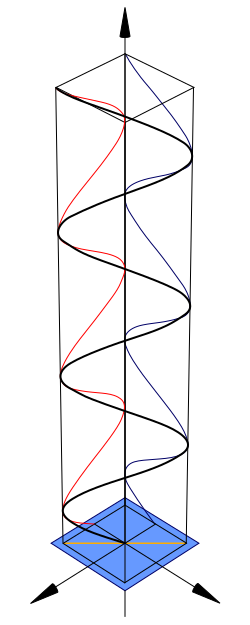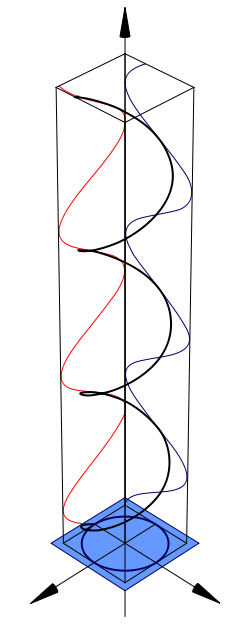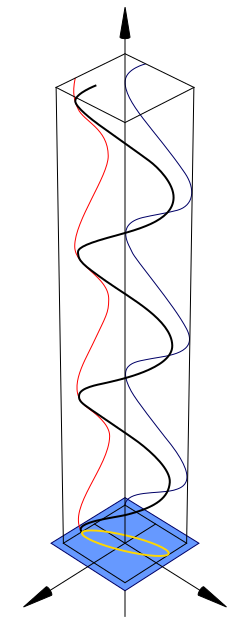Optics

| Part of a series on |
| Physics |
|---|
 |
Optics is the branch of
Most optical phenomena can be accounted for by using the
Some phenomena depend on light having both
Optical science is relevant to and studied in many related disciplines including
History

Optics began with the development of lenses by the
Greek philosophy on optics broke down into two opposing theories on how vision worked, the
Plato first articulated the emission theory, the idea that visual perception is accomplished by rays emitted by the eyes. He also commented on the parity reversal of mirrors in Timaeus.[5] Some hundred years later, Euclid (4th–3rd century BC) wrote a treatise entitled Optics where he linked vision to geometry, creating geometrical optics.[6] He based his work on Plato's emission theory wherein he described the mathematical rules of perspective and described the effects of refraction qualitatively, although he questioned that a beam of light from the eye could instantaneously light up the stars every time someone blinked.[7] Euclid stated the principle of shortest trajectory of light, and considered multiple reflections on flat and spherical mirrors.

During the
In the 13th century in medieval Europe, English bishop Robert Grosseteste wrote on a wide range of scientific topics, and discussed light from four different perspectives: an epistemology of light, a metaphysics or cosmogony of light, an etiology or physics of light, and a theology of light,[15] basing it on the works of Aristotle and Platonism. Grosseteste's most famous disciple, Roger Bacon, wrote works citing a wide range of recently translated optical and philosophical works, including those of Alhazen, Aristotle, Avicenna, Averroes, Euclid, al-Kindi, Ptolemy, Tideus, and Constantine the African. Bacon was able to use parts of glass spheres as magnifying glasses to demonstrate that light reflects from objects rather than being released from them.
The first wearable eyeglasses were invented in Italy around 1286.[16] This was the start of the optical industry of grinding and polishing lenses for these "spectacles", first in Venice and Florence in the thirteenth century,[17] and later in the spectacle making centres in both the Netherlands and Germany.[18] Spectacle makers created improved types of lenses for the correction of vision based more on empirical knowledge gained from observing the effects of the lenses rather than using the rudimentary optical theory of the day (theory which for the most part could not even adequately explain how spectacles worked).[19][20] This practical development, mastery, and experimentation with lenses led directly to the invention of the compound optical microscope around 1595, and the refracting telescope in 1608, both of which appeared in the spectacle making centres in the Netherlands.[21][22]
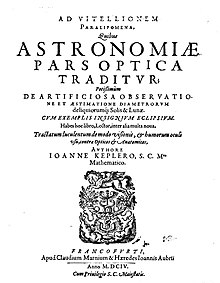

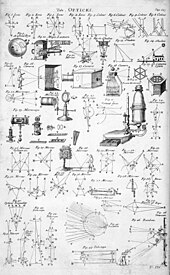
In the early 17th century,
Optical theory progressed in the mid-17th century with
Newtonian optics was generally accepted until the early 19th century when
The next development in optical theory came in 1899 when
Following the work of
Classical optics

Classical optics is divided into two main branches: geometrical (or ray) optics and physical (or wave) optics. In geometrical optics, light is considered to travel in straight lines, while in physical optics, light is considered as an electromagnetic wave.
Geometrical optics can be viewed as an approximation of physical optics that applies when the wavelength of the light used is much smaller than the size of the optical elements in the system being modelled.
Geometrical optics
When a ray of light hits the boundary between two transparent materials, it is divided into a reflected and a refracted ray.
- The law of reflection says that the reflected ray lies in the plane of incidence, and the angle of reflection equals the angle of incidence.
- The law of refraction says that the refracted ray lies in the plane of incidence, and the sine of the angle of incidence divided by the sine of the angle of refraction is a constant: where n is a constant for any two materials and a given colour of light. If the first material is air or vacuum, n is the refractive index of the second material.
The laws of reflection and refraction can be derived from Fermat's principle which states that the path taken between two points by a ray of light is the path that can be traversed in the least time.[36]
Approximations
Geometric optics is often simplified by making the paraxial approximation, or "small angle approximation". The mathematical behaviour then becomes linear, allowing optical components and systems to be described by simple matrices. This leads to the techniques of Gaussian optics and paraxial ray tracing, which are used to find basic properties of optical systems, such as approximate image and object positions and magnifications.[37]
Reflections
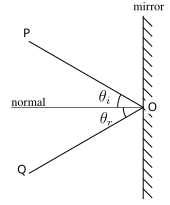
Reflections can be divided into two types: specular reflection and diffuse reflection. Specular reflection describes the gloss of surfaces such as mirrors, which reflect light in a simple, predictable way. This allows for the production of reflected images that can be associated with an actual (real) or extrapolated (virtual) location in space. Diffuse reflection describes non-glossy materials, such as paper or rock. The reflections from these surfaces can only be described statistically, with the exact distribution of the reflected light depending on the microscopic structure of the material. Many diffuse reflectors are described or can be approximated by Lambert's cosine law, which describes surfaces that have equal luminance when viewed from any angle. Glossy surfaces can give both specular and diffuse reflection.
In specular reflection, the direction of the reflected ray is determined by the angle the incident ray makes with the
For flat mirrors, the law of reflection implies that images of objects are upright and the same distance behind the mirror as the objects are in front of the mirror. The image size is the same as the object size. The law also implies that mirror images are parity inverted, which we perceive as a left-right inversion. Images formed from reflection in two (or any even number of) mirrors are not parity inverted. Corner reflectors produce reflected rays that travel back in the direction from which the incident rays came.[39] This is called retroreflection.
Mirrors with curved surfaces can be modelled by ray tracing and using the law of reflection at each point on the surface. For mirrors with parabolic surfaces, parallel rays incident on the mirror produce reflected rays that converge at a common focus. Other curved surfaces may also focus light, but with aberrations due to the diverging shape causing the focus to be smeared out in space. In particular, spherical mirrors exhibit spherical aberration. Curved mirrors can form images with a magnification greater than or less than one, and the magnification can be negative, indicating that the image is inverted. An upright image formed by reflection in a mirror is always virtual, while an inverted image is real and can be projected onto a screen.[40]
Refractions
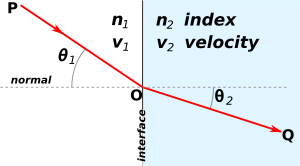
Refraction occurs when light travels through an area of space that has a changing index of refraction; this principle allows for lenses and the focusing of light. The simplest case of refraction occurs when there is an
where θ1 and θ2 are the angles between the normal (to the interface) and the incident and refracted waves, respectively.[38]
The index of refraction of a medium is related to the speed, v, of light in that medium by
Snell's Law can be used to predict the deflection of light rays as they pass through linear media as long as the indexes of refraction and the geometry of the media are known. For example, the propagation of light through a prism results in the light ray being deflected depending on the shape and orientation of the prism. In most materials, the index of refraction varies with the frequency of the light, known as dispersion. Taking this into account, Snell's Law can be used to predict how a prism will disperse light into a spectrum.[41] The discovery of this phenomenon when passing light through a prism is famously attributed to Isaac Newton.
Some media have an index of refraction which varies gradually with position and, therefore, light rays in the medium are curved. This effect is responsible for mirages seen on hot days: a change in index of refraction air with height causes light rays to bend, creating the appearance of specular reflections in the distance (as if on the surface of a pool of water). Optical materials with varying indexes of refraction are called gradient-index (GRIN) materials. Such materials are used to make gradient-index optics.[42]
For light rays travelling from a material with a high index of refraction to a material with a low index of refraction, Snell's law predicts that there is no θ2 when θ1 is large. In this case, no transmission occurs; all the light is reflected. This phenomenon is called total internal reflection and allows for fibre optics technology. As light travels down an optical fibre, it undergoes total internal reflection allowing for essentially no light to be lost over the length of the cable.[43]
Lenses
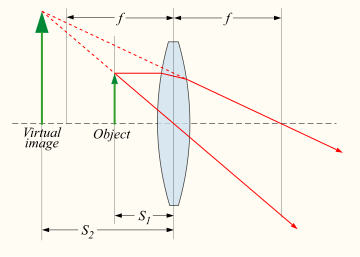
A device that produces converging or diverging light rays due to refraction is known as a lens. Lenses are characterized by their
Ray tracing can be used to show how images are formed by a lens. For a thin lens in air, the location of the image is given by the simple equation
where S1 is the distance from the object to the lens, θ2 is the distance from the lens to the image, and f is the focal length of the lens. In the sign convention used here, the object and image distances are positive if the object and image are on opposite sides of the lens.[45]

Incoming parallel rays are focused by a converging lens onto a spot one focal length from the lens, on the far side of the lens. This is called the rear focal point of the lens. Rays from an object at a finite distance are focused further from the lens than the focal distance; the closer the object is to the lens, the further the image is from the lens.
With diverging lenses, incoming parallel rays diverge after going through the lens, in such a way that they seem to have originated at a spot one focal length in front of the lens. This is the lens's front focal point. Rays from an object at a finite distance are associated with a virtual image that is closer to the lens than the focal point, and on the same side of the lens as the object. The closer the object is to the lens, the closer the virtual image is to the lens. As with mirrors, upright images produced by a single lens are virtual, while inverted images are real.[46]
Lenses suffer from aberrations that distort images. Monochromatic aberrations occur because the geometry of the lens does not perfectly direct rays from each object point to a single point on the image, while chromatic aberration occurs because the index of refraction of the lens varies with the wavelength of the light.[47]
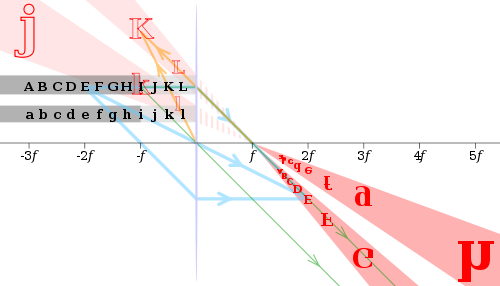
Physical optics
In physical optics, light is considered to propagate as waves. This model predicts phenomena such as interference and diffraction, which are not explained by geometric optics. The
The wave model can be used to make predictions about how an optical system will behave without requiring an explanation of what is "waving" in what medium. Until the middle of the 19th century, most physicists believed in an "ethereal" medium in which the light disturbance propagated.
Modelling and design of optical systems using physical optics
Many simplified approximations are available for analysing and designing optical systems. Most of these use a single scalar quantity to represent the electric field of the light wave, rather than using a vector model with orthogonal electric and magnetic vectors.[50] The Huygens–Fresnel equation is one such model. This was derived empirically by Fresnel in 1815, based on Huygens' hypothesis that each point on a wavefront generates a secondary spherical wavefront, which Fresnel combined with the principle of superposition of waves. The Kirchhoff diffraction equation, which is derived using Maxwell's equations, puts the Huygens-Fresnel equation on a firmer physical foundation. Examples of the application of Huygens–Fresnel principle can be found in the articles on diffraction and Fraunhofer diffraction.
More rigorous models, involving the modelling of both electric and magnetic fields of the light wave, are required when dealing with materials whose electric and magnetic properties affect the interaction of light with the material. For instance, the behaviour of a light wave interacting with a metal surface is quite different from what happens when it interacts with a dielectric material. A vector model must also be used to model polarised light.
Numerical modeling techniques such as the finite element method, the boundary element method and the transmission-line matrix method can be used to model the propagation of light in systems which cannot be solved analytically. Such models are computationally demanding and are normally only used to solve small-scale problems that require accuracy beyond that which can be achieved with analytical solutions.[51]
All of the results from geometrical optics can be recovered using the techniques of
Gaussian beam propagation is a simple paraxial physical optics model for the propagation of coherent radiation such as laser beams. This technique partially accounts for diffraction, allowing accurate calculations of the rate at which a laser beam expands with distance, and the minimum size to which the beam can be focused. Gaussian beam propagation thus bridges the gap between geometric and physical optics.[52]
Superposition and interference
In the absence of
| combined waveform |

| |
| wave 1 | ||
| wave 2 | ||
| Two waves in phase | Two waves 180° out of phase | |

Since the Huygens–Fresnel principle states that every point of a wavefront is associated with the production of a new disturbance, it is possible for a wavefront to interfere with itself constructively or destructively at different locations producing bright and dark fringes in regular and predictable patterns.[55] Interferometry is the science of measuring these patterns, usually as a means of making precise determinations of distances or angular resolutions.[56] The Michelson interferometer was a famous instrument which used interference effects to accurately measure the speed of light.[57]
The appearance of
Constructive interference in thin films can create a strong reflection of light in a range of wavelengths, which can be narrow or broad depending on the design of the coating. These films are used to make
Diffraction and optical resolution

Diffraction is the process by which light interference is most commonly observed. The effect was first described in 1665 by
The first physical optics model of diffraction that relied on the Huygens–Fresnel principle was developed in 1803 by Thomas Young in his interference experiments with the interference patterns of two closely spaced slits. Young showed that his results could only be explained if the two slits acted as two unique sources of waves rather than corpuscles.[63] In 1815 and 1818, Augustin-Jean Fresnel firmly established the mathematics of how wave interference can account for diffraction.[64]
The simplest physical models of diffraction use equations that describe the angular separation of light and dark fringes due to light of a particular wavelength (λ). In general, the equation takes the form
This equation is modified slightly to take into account a variety of situations such as diffraction through a single gap, diffraction through multiple slits, or diffraction through a diffraction grating that contains a large number of slits at equal spacing.[66] More complicated models of diffraction require working with the mathematics of Fresnel or Fraunhofer diffraction.[67]
Diffraction effects limit the ability of an optical detector to
The size of such a disk is given byFor astronomical imaging, the atmosphere prevents optimal resolution from being achieved in the visible spectrum due to the atmospheric
Dispersion and scattering

Refractive processes take place in the physical optics limit, where the wavelength of light is similar to other distances, as a kind of scattering. The simplest type of scattering is
Dispersion occurs when different frequencies of light have different
The separation of colours by a prism is an example of normal dispersion. At the surfaces of the prism, Snell's law predicts that light incident at an angle θ to the normal will be refracted at an angle arcsin(sin (θ) / n). Thus, blue light, with its higher refractive index, is bent more strongly than red light, resulting in the well-known rainbow pattern.[41]

Material dispersion is often characterised by the Abbe number, which gives a simple measure of dispersion based on the index of refraction at three specific wavelengths. Waveguide dispersion is dependent on the propagation constant.[74] Both kinds of dispersion cause changes in the group characteristics of the wave, the features of the wave packet that change with the same frequency as the amplitude of the electromagnetic wave. "Group velocity dispersion" manifests as a spreading-out of the signal "envelope" of the radiation and can be quantified with a group dispersion delay parameter:
where vg is the group velocity.[75] For a uniform medium, the group velocity is
where n is the index of refraction and c is the speed of light in a vacuum.[76] This gives a simpler form for the dispersion delay parameter:
If D is less than zero, the medium is said to have positive dispersion or normal dispersion. If D is greater than zero, the medium has negative dispersion. If a light pulse is propagated through a normally dispersive medium, the result is the higher frequency components slow down more than the lower frequency components. The pulse therefore becomes positively chirped, or up-chirped, increasing in frequency with time. This causes the spectrum coming out of a prism to appear with red light the least refracted and blue/violet light the most refracted. Conversely, if a pulse travels through an anomalously (negatively) dispersive medium, high-frequency components travel faster than the lower ones, and the pulse becomes negatively chirped, or down-chirped, decreasing in frequency with time.[77]
The result of group velocity dispersion, whether negative or positive, is ultimately temporal spreading of the pulse. This makes dispersion management extremely important in optical communications systems based on
Polarisation
Polarisation is a general property of waves that describes the orientation of their oscillations. For
The typical way to consider polarisation is to keep track of the orientation of the electric field
In the leftmost figure above, the x and y components of the light wave are in phase. In this case, the ratio of their strengths is constant, so the direction of the electric vector (the vector sum of these two components) is constant. Since the tip of the vector traces out a single line in the plane, this special case is called linear polarisation. The direction of this line depends on the relative amplitudes of the two components.[80]
In the middle figure, the two orthogonal components have the same amplitudes and are 90° out of phase. In this case, one component is zero when the other component is at maximum or minimum amplitude. There are two possible phase relationships that satisfy this requirement: the x component can be 90° ahead of the y component or it can be 90° behind the y component. In this special case, the electric vector traces out a circle in the plane, so this polarisation is called circular polarisation. The rotation direction in the circle depends on which of the two-phase relationships exists and corresponds to right-hand circular polarisation and left-hand circular polarisation.[81]
In all other cases, where the two components either do not have the same amplitudes and/or their phase difference is neither zero nor a multiple of 90°, the polarisation is called elliptical polarisation because the electric vector traces out an ellipse in the plane (the polarisation ellipse).[82] This is shown in the above figure on the right. Detailed mathematics of polarisation is done using Jones calculus and is characterised by the Stokes parameters.[83]
Changing polarisation
Media that have different indexes of refraction for different polarisation modes are called

Media that reduce the amplitude of certain polarisation modes are called dichroic, with devices that block nearly all of the radiation in one mode known as polarising filters or simply "
A beam of unpolarised light can be thought of as containing a uniform mixture of linear polarisations at all possible angles. Since the average value of cos2 θ is 1/2, the transmission coefficient becomes
In practice, some light is lost in the polariser and the actual transmission of unpolarised light will be somewhat lower than this, around 38% for Polaroid-type polarisers but considerably higher (>49.9%) for some birefringent prism types.[89]
In addition to birefringence and dichroism in extended media, polarisation effects can also occur at the (reflective) interface between two materials of different refractive index. These effects are treated by the Fresnel equations. Part of the wave is transmitted and part is reflected, with the ratio depending on the angle of incidence and the angle of refraction. In this way, physical optics recovers Brewster's angle.[90] When light reflects from a thin film on a surface, interference between the reflections from the film's surfaces can produce polarisation in the reflected and transmitted light.
Natural light

Most sources of electromagnetic radiation contain a large number of atoms or molecules that emit light. The orientation of the electric fields produced by these emitters may not be
Light reflected by shiny transparent materials is partly or fully polarised, except when the light is normal (perpendicular) to the surface. It was this effect that allowed the mathematician Étienne-Louis Malus to make the measurements that allowed for his development of the first mathematical models for polarised light. Polarisation occurs when light is scattered in the
Modern optics
Modern optics encompasses the areas of optical science and engineering that became popular in the 20th century. These areas of optical science typically relate to the electromagnetic or quantum properties of light but do include other topics. A major subfield of modern optics,
Specialty areas of optics research include the study of how light interacts with specific materials as in
Today, the pure science of optics is called optical science or
Lasers
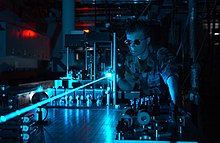
A laser is a device that emits light, a kind of electromagnetic radiation, through a process called stimulated emission. The term laser is an acronym for 'Light Amplification by Stimulated Emission of Radiation'.[95] Laser light is usually spatially coherent, which means that the light either is emitted in a narrow, low-divergence beam, or can be converted into one with the help of optical components such as lenses. Because the microwave equivalent of the laser, the maser, was developed first, devices that emit microwave and radio frequencies are usually called masers.[96]
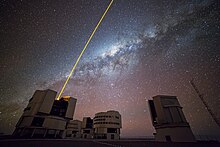
The first working laser was demonstrated on 16 May 1960 by
Kapitsa–Dirac effect
The Kapitsa–Dirac effect causes beams of particles to diffract as the result of meeting a standing wave of light. Light can be used to position matter using various phenomena (see optical tweezers).
Applications
Optics is part of everyday life. The ubiquity of
Human eye

The human eye functions by focusing light onto a layer of
There are two types of photoreceptor cells, rods and cones, which are sensitive to different aspects of light.[103] Rod cells are sensitive to the intensity of light over a wide frequency range, thus are responsible for black-and-white vision. Rod cells are not present on the fovea, the area of the retina responsible for central vision, and are not as responsive as cone cells to spatial and temporal changes in light. There are, however, twenty times more rod cells than cone cells in the retina because the rod cells are present across a wider area. Because of their wider distribution, rods are responsible for peripheral vision.[104]
In contrast, cone cells are less sensitive to the overall intensity of light, but come in three varieties that are sensitive to different frequency-ranges and thus are used in the perception of
Ciliary muscles around the lens allow the eye's focus to be adjusted. This process is known as
Defects in vision can be explained using optical principles. As people age, the lens becomes less flexible and the near point recedes from the eye, a condition known as
All of these conditions can be corrected using
The optical power of corrective lenses is measured in
Visual effects

Optical illusions (also called visual illusions) are characterized by visually perceived images that differ from objective reality. The information gathered by the eye is processed in the brain to give a
Cognitive illusions include some which result from the unconscious misapplication of certain optical principles. For example, the
Another type of optical illusion exploits broken patterns to trick the mind into perceiving symmetries or asymmetries that are not present. Examples include the
Optical instruments
Single lenses have a variety of applications including
Microscopes were first developed with just two lenses: an
The first telescopes, called refracting telescopes, were also developed with a single objective and eyepiece lens. In contrast to the microscope, the objective lens of the telescope was designed with a large focal length to avoid optical aberrations. The objective focuses an image of a distant object at its focal point which is adjusted to be at the focal point of an eyepiece of a much smaller focal length. The main goal of a telescope is not necessarily magnification, but rather the collection of light which is determined by the physical size of the objective lens. Thus, telescopes are normally indicated by the diameters of their objectives rather than by the magnification which can be changed by switching eyepieces. Because the magnification of a telescope is equal to the focal length of the objective divided by the focal length of the eyepiece, smaller focal-length eyepieces cause greater magnification.[113]
Since crafting large lenses is much more difficult than crafting large mirrors, most modern telescopes are reflecting telescopes, that is, telescopes that use a primary mirror rather than an objective lens. The same general optical considerations apply to reflecting telescopes that applied to refracting telescopes, namely, the larger the primary mirror, the more light collected, and the magnification is still equal to the focal length of the primary mirror divided by the focal length of the eyepiece. Professional telescopes generally do not have eyepieces and instead place an instrument (often a charge-coupled device) at the focal point instead.[114]
Photography


The optics of photography involves both lenses and the medium in which the electromagnetic radiation is recorded, whether it be a
- Exposure ∝ ApertureArea × ExposureTime × SceneLuminance[115]
In other words, the smaller the aperture (giving greater depth of focus), the less light coming in, so the length of time has to be increased (leading to possible blurriness if motion occurs). An example of the use of the law of reciprocity is the Sunny 16 rule which gives a rough estimate for the settings needed to estimate the proper exposure in daylight.[116]
A camera's aperture is measured by a unitless number called the f-number or f-stop, f/#, often notated as , and given by
where is the focal length, and is the diameter of the entrance pupil. By convention, "f/#" is treated as a single symbol, and specific values of f/# are written by replacing the number sign with the value. The two ways to increase the f-stop are to either decrease the diameter of the entrance pupil or change to a longer focal length (in the case of a zoom lens, this can be done by simply adjusting the lens). Higher f-numbers also have a larger depth of field due to the lens approaching the limit of a pinhole camera which is able to focus all images perfectly, regardless of distance, but requires very long exposure times.[117]
The field of view that the lens will provide changes with the focal length of the lens. There are three basic classifications based on the relationship to the diagonal size of the film or sensor size of the camera to the focal length of the lens:[118]
- Normal lens: angle of view of about 50° (called normal because this angle considered roughly equivalent to human vision[118]) and a focal length approximately equal to the diagonal of the film or sensor.[119]
- Wide-angle lens: angle of view wider than 60° and focal length shorter than a normal lens.[120]
- Long focus lens: angle of view narrower than a normal lens. This is any lens with a focal length longer than the diagonal measure of the film or sensor.[121] The most common type of long focus lens is the telephoto lens, a design that uses a special telephoto group to be physically shorter than its focal length.[122]
Modern zoom lenses may have some or all of these attributes.
The absolute value for the exposure time required depends on how sensitive to light the medium being used is (measured by the film speed, or, for digital media, by the quantum efficiency).[123] Early photography used media that had very low light sensitivity, and so exposure times had to be long even for very bright shots. As technology has improved, so has the sensitivity through film cameras and digital cameras.[124]
Other results from physical and geometrical optics apply to camera optics. For example, the maximum resolution capability of a particular camera set-up is determined by the
Atmospheric optics

The unique optical properties of the atmosphere cause a wide range of spectacular optical phenomena. The blue colour of the sky is a direct result of Rayleigh scattering which redirects higher frequency (blue) sunlight back into the field of view of the observer. Because blue light is scattered more easily than red light, the sun takes on a reddish hue when it is observed through a thick atmosphere, as during a
Mirages are optical phenomena in which light rays are bent due to thermal variations in the refraction index of air, producing displaced or heavily distorted images of distant objects. Other dramatic optical phenomena associated with this include the Novaya Zemlya effect where the sun appears to rise earlier than predicted with a distorted shape. A spectacular form of refraction occurs with a temperature inversion called the Fata Morgana where objects on the horizon or even beyond the horizon, such as islands, cliffs, ships or icebergs, appear elongated and elevated, like "fairy tale castles".[127]
Rainbows are the result of a combination of internal reflection and dispersive refraction of light in raindrops. A single reflection off the backs of an array of raindrops produces a rainbow with an angular size on the sky that ranges from 40° to 42° with red on the outside. Double rainbows are produced by two internal reflections with angular size of 50.5° to 54° with violet on the outside. Because rainbows are seen with the sun 180° away from the centre of the rainbow, rainbows are more prominent the closer the sun is to the horizon.[128]
See also
- Ion optics
- Important publications in optics
- List of optical topics
- List of textbooks in electromagnetism
References
- ^ a b McGraw-Hill Encyclopedia of Science and Technology (5th ed.). McGraw-Hill. 1993.
- ^ "World's oldest telescope?". BBC News. July 1, 1999. Archived from the original on February 1, 2009. Retrieved Jan 3, 2010.
- ISBN 978-0-19-283098-2.
- ^ A History Of The Eye Archived 2012-01-20 at the Wayback Machine. stanford.edu. Retrieved 2012-06-10.
- ISBN 978-0-486-43231-1.
- ISBN 978-0-89859-289-4. Archivedfrom the original on 2016-05-03.
- ISBN 978-0-387-98523-7.
- ^ ISBN 978-0-87169-862-9.
- ISBN 978-0-521-52069-0.
- ^ S2CID 144361526.
- S2CID 170628785.
Works cited
- Hecht, Eugene (2017). Optics (5th ed.). Pearson Education. ISBN 978-0-133-97722-6.
- Young, Hugh D.; Freedman, Roger A. (2020). University Physics: Extended Version With Modern Physics (15th ed.). Pearson Education. ISBN 978-1-292-31473-0.
Further reading
- Born, Max; Wolf, Emil (2002). ISBN 978-1-139-64340-5.
- Fowles, Grant R. (1975). Introduction to Modern Optics (4th ed.). Addison-Wesley Longman.
- Lipson, Stephen G.; Lipson, Henry; Tannhauser, David Stefan (1995). Optical Physics. Cambridge University Press. ISBN 978-0-521-43631-1.
- Serway, Raymond A.; Jewett, John W. (2004). Physics for Scientists and Engineers (6th, Illustrated ed.). Belmont, California: Thomson-Brooks/Cole. ISBN 978-0-534-40842-8.
- Tipler, Paul A.; Mosca, Gene (2004). Physics for Scientists and Engineers: Electricity, Magnetism, Light, and Elementary Modern Physics. Vol. 2. W. H. Freeman. ISBN 978-0-7167-0810-0.
External links
- Relevant discussions
- Optics on In Our Time at the BBC
- Textbooks and tutorials
- Light and Matter – an open-source textbook, containing a treatment of optics in ch. 28-32
- Optics2001 – Optics library and community
- Fundamental Optics – Melles Griot Technical Guide
- Physics of Light and Optics – Brigham Young University Undergraduate Book
- Optics for PV – a step-by-step introduction to classical optics
- Wikibooks modules
- Further reading
- Societies
|
|










